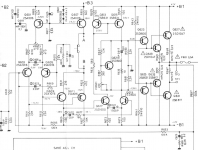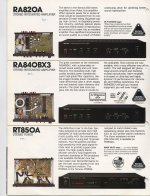Often people make no distinction between good or bad amps, or preferred or not preferred amps.
For me a 'good' amp is one that is transparent to the signal, taking away as little as possible, adding as little as possible.
Very often this is a very different ranking than preferred or less preferred amps.
Jan
you can always hear when an amp-speaker combo sounds good or bad....
Matti Otala
Can you upload the pictures as PDF scanned at 600 dpi.? What is the original language? I can send you the OCRed files for editing and publication.
--G Annaji Sarma.
found by chance : Meeting with Matti Otala (magazine "l' Audiophile")
Who can convert the file format from attached jpg-files by OCR software to transfer the text in a translation resp. language tool (e. g. in "Google) ?
Can you upload the pictures as PDF scanned at 600 dpi.? What is the original language? I can send you the OCRed files for editing and publication.
--G Annaji Sarma.
Last edited:
... yes, but nobody can always say clearly, why.you can always hear when an amp-speaker combo sounds good or bad....
The files of all articles from "l' Audiophile" are from there:Can you upload the pictures as PDF scanned at 600 dpi.? What is the original language? I can send you the OCRed files for editing and publication.
--G Annaji Sarma.
index
Maybe it is possible to convert from jpg in doc by Abbyy FineReader for the aim of comfortable translation in Google's language tool.
check also this thread
https://www.diyaudio.com/forums/sol...amp-low-resolution-schematic.html#post6749571
Last edited:
Do you guys know if Matti Otala designed the HK750 ?
https://www.hifiengine.com/manual_library/harman-kardon/hk750.shtml
what do you guys make of the 750 ?
https://www.hifiengine.com/manual_library/harman-kardon/hk750.shtml
what do you guys make of the 750 ?
Hi,
if anyone interested to try Matti Otala amplifier, it is easy to do so by buying used Rotel RA-820bx3 / RA-820bx4 / RA-840bx3 / RA-840bx4.
Where 820bx3/4 is without tone controls and 840bx3/4 is with tone controls.
Check it out Rotel circuit attached.
if anyone interested to try Matti Otala amplifier, it is easy to do so by buying used Rotel RA-820bx3 / RA-820bx4 / RA-840bx3 / RA-840bx4.
Where 820bx3/4 is without tone controls and 840bx3/4 is with tone controls.
Check it out Rotel circuit attached.
Attachments
This is a long and old thread, but still some more things. In a finnish hifi-magazin was a long story Matti Otala in memoriam and here is a prewiev about it. Google translator maybe helps for people who don't uderstand finnish language. I think most of readers don't understand. Paper magazine number 1/2016 had some more things to read.
https://www.hifimaailma.fi/uutinen/matti-otala-19392015-6.108.12698.6e4eee7be7
Picture is taken at Matti's home for sure and place is "Lauttasaari" in Helsinki, Finland, not so much far away for me. I never meet Matti but send him an email once and what I think now, it was too late because year was around 2009, and all of you know what happened to Matti (after reading this thread completely). Instead of this I have meet many people who really knew Otala, one of this is Jorma Salmi, founder of Gragient Oy, sadly Jorma is also passed away, but Gradient still makes speakers in Porvoo Finland.
https://www.stereophile.com/floorloudspeakers/gradient_helsinki_15_loudspeaker/index.html
Back to Matti Otala. He made Finlands first DIY television receiver (year 1956) and before this a DIY crystal and tube radio. At year 1956 here in Finland was no television broadcast, so they were watching Estonian television from Tallinn. I think it is still possible because some ham radio people say so. In any case here in Helsinki is possible to listen FM radio from Tallinn with a good receiver. Otala's Television still exist and works. It is in a technology museum here in Helsinki, maybe a place worth of visiting if someone comes to Finland.
https://www.tekniikanmuseo.fi/en/
And "one more thing" a man who first started to think transient distortion was Otala's friend Tapio Köykkä, a finnish engineer and inventor who had also some patents like FI62917C (a symmetrical transistor amplifier) google patens find them all if someone wants to look. Köykkä write an article to Finnish ERT magazine number 1/1969, exactly 55 years ago. And a big debate started. No one could imagine that something could be wrong inside "closed loop" if global feedback was used. Otala trusted Köykkä and published first article one year later 1970. This is how it all started from here.
I hope this don't open " A big can of worms". You know what I mean ...
https://www.hifimaailma.fi/uutinen/matti-otala-19392015-6.108.12698.6e4eee7be7
Picture is taken at Matti's home for sure and place is "Lauttasaari" in Helsinki, Finland, not so much far away for me. I never meet Matti but send him an email once and what I think now, it was too late because year was around 2009, and all of you know what happened to Matti (after reading this thread completely). Instead of this I have meet many people who really knew Otala, one of this is Jorma Salmi, founder of Gragient Oy, sadly Jorma is also passed away, but Gradient still makes speakers in Porvoo Finland.
https://www.stereophile.com/floorloudspeakers/gradient_helsinki_15_loudspeaker/index.html
Back to Matti Otala. He made Finlands first DIY television receiver (year 1956) and before this a DIY crystal and tube radio. At year 1956 here in Finland was no television broadcast, so they were watching Estonian television from Tallinn. I think it is still possible because some ham radio people say so. In any case here in Helsinki is possible to listen FM radio from Tallinn with a good receiver. Otala's Television still exist and works. It is in a technology museum here in Helsinki, maybe a place worth of visiting if someone comes to Finland.
https://www.tekniikanmuseo.fi/en/
And "one more thing" a man who first started to think transient distortion was Otala's friend Tapio Köykkä, a finnish engineer and inventor who had also some patents like FI62917C (a symmetrical transistor amplifier) google patens find them all if someone wants to look. Köykkä write an article to Finnish ERT magazine number 1/1969, exactly 55 years ago. And a big debate started. No one could imagine that something could be wrong inside "closed loop" if global feedback was used. Otala trusted Köykkä and published first article one year later 1970. This is how it all started from here.
I hope this don't open " A big can of worms". You know what I mean ...
Tapio Köykkä
Once you mentioned Tapio's name, please find his tube patents, transistor patent and paper on TIM distortion
Once you mentioned Tapio's name, please find his tube patents, transistor patent and paper on TIM distortion
Attachments
-
27332p1.pdf79.4 KB · Views: 82
-
27332p2.pdf46.5 KB · Views: 83
-
29642p3.pdf10.9 KB · Views: 61
-
29642p2.pdf26.2 KB · Views: 52
-
29642p1.pdf74.4 KB · Views: 60
-
27332p4.pdf9.7 KB · Views: 64
-
27332p3.pdf8.4 KB · Views: 70
-
29642p4.pdf11.7 KB · Views: 61
-
29642p5.pdf11.3 KB · Views: 75
-
FI62917C.pdf228.9 KB · Views: 74
-
koykka.pdf392.6 KB · Views: 109
I interviewed Jan Lohstroh, Matti's buddy in designing their (in)famous low tim amp:
https://linearaudio.net/sites/linearaudio.net/files/2022-12/An afternoon with Jan Lohstroh.pdf
In my view, Matti and Jan made the important contribution to make us aware of the importance of adequate slew rate in power amps.
What they got wrong was that good slew rate need wide and flat open loop bandwidth. That send a lot of designers the wrong way, including John Curl.
People like Bob Cordell showed that perfectly adequate slew rate can be had from high gain low open loop bandwidth designs.
https://www.cordellaudio.com/papers/another_view_of_tim.pdf
https://www.cordellaudio.com/papers/another_view_of_tim_II.pdf
Jan
https://linearaudio.net/sites/linearaudio.net/files/2022-12/An afternoon with Jan Lohstroh.pdf
In my view, Matti and Jan made the important contribution to make us aware of the importance of adequate slew rate in power amps.
What they got wrong was that good slew rate need wide and flat open loop bandwidth. That send a lot of designers the wrong way, including John Curl.
People like Bob Cordell showed that perfectly adequate slew rate can be had from high gain low open loop bandwidth designs.
https://www.cordellaudio.com/papers/another_view_of_tim.pdf
https://www.cordellaudio.com/papers/another_view_of_tim_II.pdf
Jan
A good proof of Jan’s post is opamps. Dominant pole compensated opamps (most VFA opamps in other words) have open loop bandwidths of just a few Hz (often < 10 Hz) but slew rates of 50 to 100V/us. Some examples are the OPA1652, LM4562, AD797 etc. Slew rate and open loop bandwidth are set independently of each other. In a power amplifier, the designer has even more room to play with because the power consumption restrictions in an IC opamp are generally not a concern. So you can design for a very high open loop gain of 120 dB or close to it whilst simultaneously running the front end diff pair ‘rich’ at 5~10 mA which with a say 22~33pF comp cap will give high slew rates.
Hi,
if anyone interested to try Matti Otala amplifier, it is easy to do so by buying used Rotel RA-820bx3 / RA-820bx4 / RA-840bx3 / RA-840bx4.
Where 820bx3/4 is without tone controls and 840bx3/4 is with tone controls.
Check it out Rotel circuit attached.
I managed to squeeze 80-90W at 6 ohms from RA820BX4... I replaced a few components. The original design was quite bad... the PCB tracks were burning; the PCB was turning into charcoal. I circled in red the components that I changed... I also installed the heatsinks where (they were really) needed.
The sound of these Rotels was always too rough, too clinical. I managed to smooth that out a fair bit... and then gave the amp to my kids to enjoy.
I did a lot of work on the PCB underside as well...
I first learned about TIM from Leach's 1976 article "Build a Low TIM Amplifier".
In hindsight, the article contained a lot of misinformation. However, the solution proposed (make the open-loop linear and wide-bandwidth) does indeed preclude slew-rate distortion. It is not the only solution. Making the open-loop linear and having a sufficiently high slew rate is the direct way of avoiding slewing.
Both methods work and can produce objectively good amplifiers. The THD wars have pushed loop gain to astronomical levels, and so the wide bandwidth method has fallen out of favor.
Ed
In hindsight, the article contained a lot of misinformation. However, the solution proposed (make the open-loop linear and wide-bandwidth) does indeed preclude slew-rate distortion. It is not the only solution. Making the open-loop linear and having a sufficiently high slew rate is the direct way of avoiding slewing.
Both methods work and can produce objectively good amplifiers. The THD wars have pushed loop gain to astronomical levels, and so the wide bandwidth method has fallen out of favor.
Ed
Limiting the amplifier bandwidth can also be used to avoid slewing distortion. However, it should be noted the TIM/slewing issue is very well understood now.
- Home
- Amplifiers
- Solid State
- Matti Otala - An Amplifier Milestone. Dead or Alive


